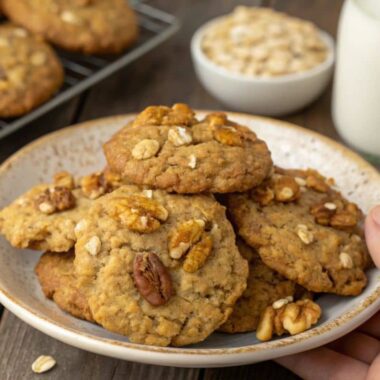Is there anything more satisfying than biting into a perfectly baked cookie? Whether it’s gooey chocolate chip or buttery shortbread, cookies hold a special place in our hearts—and our stomachs. But let’s face it: baking isn’t always smooth sailing. Sometimes, cookies crumble in your hands, and not in the good way! So, what makes a cookie crumble? Let’s dive into the science and secrets behind crafting cookies that hold together beautifully while tasting heavenly.
Table of Contents
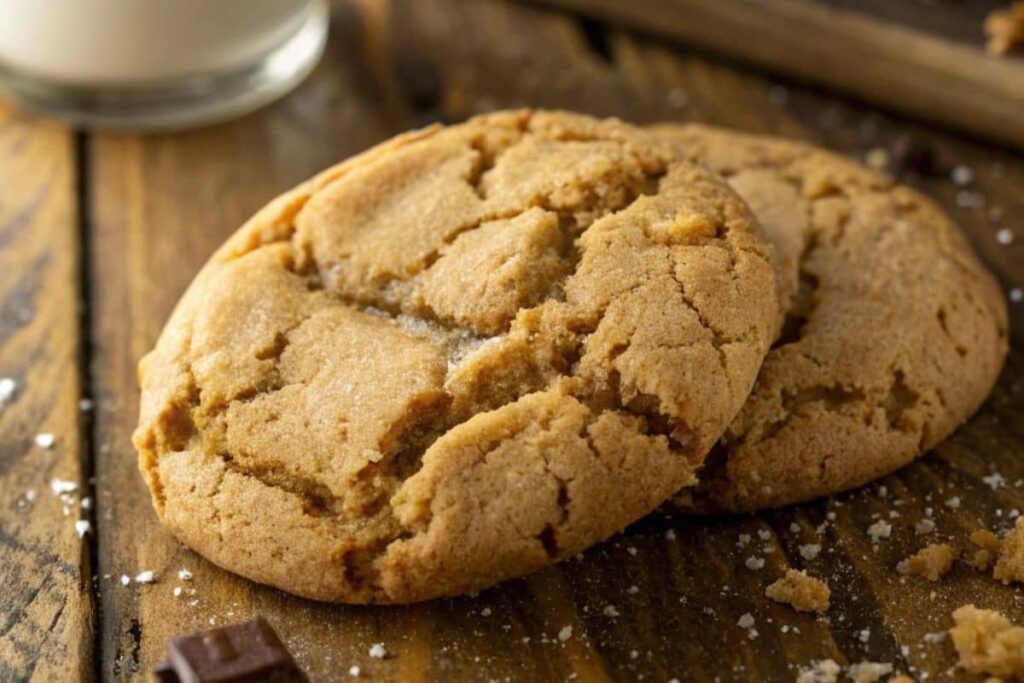
Understanding Why Cookies Crumble: Common Factors
The Role of Ingredients in Cookie Texture
Ever wondered why some cookies are soft and chewy, while others are crisp and crumbly? It all comes down to the ingredients. Baking is more like chemistry than cooking—it’s all about balance. Let’s break it down:
- Flour: Too much flour can dry out your cookies, making them prone to crumbling. Too little? They’ll be a sticky mess!
- Butter: The type and amount of fat you use directly impact texture. Melted butter often leads to flatter cookies, while cold butter gives them structure.
- Sugar: Brown sugar tends to add moisture, while granulated sugar can make cookies more brittle.
“Baking is all about precision. A slight tweak in your ingredients can turn chewy cookies into a crumbly disaster!”
How Mixing Techniques Impact Dough Consistency
Did you know overmixing your dough can ruin your baked treats? When you mix too much, the gluten in the flour overdevelops, leading to a tough, crumbly texture. The solution? Mix until just combined. Trust me, your treats will thank you!
Baking Time and Temperature: Striking the Perfect Balance
Baking is like walking a tightrope—too short, and the center stays underdone; too long, and everything turns dry and crumbly. Always preheat your oven (no shortcuts here) and follow the recommended baking time. If in doubt, go for the lower end of the time range and check often.
Ingredients Breakdown: How Each Component Affects Crumbling
Flour Types: All-Purpose vs. Cake Flour
The type of flour you use matters big time. All-purpose flour is great for sturdy baked goods, but if you’re after something softer, cake flour might be your secret weapon. Its lower protein content means less gluten, resulting in a tender texture.
Butter, Oil, and Shortening: The Fat Factor
Not all fats are created equal. Butter gives a rich flavor but can also cause more spreading. Shortening, on the other hand, helps maintain shape but lacks that buttery goodness. Oil? It adds moisture but can make the texture feel a bit greasy. Choose wisely based on the result you’re aiming for.
Sugar Varieties: Granulated, Brown, and Their Effects
Brown sugar contains molasses, which adds moisture and chewiness. Granulated sugar, however, is all about crispness. Want the best of both worlds? Use a mix of the two. Pro tip: Slightly underbake treats made with brown sugar for an ultra-soft center.
Eggs: What Happens When You Use Too Many or Too Few
Eggs bind everything together, so skipping them or using too few might leave you with a crumbly texture. Too many, and the result will be dense. One large egg is usually the sweet spot for most recipes. For a chewier texture, try adding an extra egg yolk.
Troubleshooting Common Cookie Problems
Why Do My Cookies Spread Too Much?
If your dough spreads too much, your butter might be too warm. Pop it in the fridge for 30 minutes before baking. This slows the spread, giving you thick, delicious treats. 🍪
What Causes Overly Hard or Dry Cookies?
A dry texture is a clear sign of overbaking. Pull them out when the edges are golden, and the centers are still soft—they’ll continue cooking on the baking sheet. Too much flour can also be a culprit, so measure carefully!
The Mystery of Uneven Baking
If some of your treats turn out perfect while others are underbaked, your baking sheet might be to blame. Uneven heat distribution can wreak havoc. Use heavy-duty sheets or rotate them halfway through baking for even results.
Why Do My Cookies Crumble When Handled?
This is a common issue and usually comes down to dry dough. If the mixture feels too crumbly, add a tablespoon of milk or cream and mix gently. It’ll bring the dough back to life!
Expert Hacks for Avoiding Crumbling Cookies
Measure Ingredients Accurately
Guesswork is your enemy when it comes to baking. Invest in a kitchen scale or use measuring cups correctly. Remember, “spoon and level” is the best way to measure flour—never scoop directly from the bag.
Choose the Right Fat for Your Recipe
Want a dough that holds together well? Butter is usually the way to go. But if you’re baking in hot weather or need more stability, a mix of butter and shortening can do wonders.
Add a Touch of Cornstarch for Stability
A teaspoon of cornstarch can transform your baked goods. It adds tenderness and helps them hold their shape, especially for delicate recipes like sugar cookies.
Chill Your Dough Before Baking
This simple step works wonders. Chilling firms up the fat in your dough, preventing excess spreading and helping your treats keep their structure. Plus, it deepens the flavor—double win!
Use a Scoop for Even Sizing
Even-sized portions bake evenly. A scoop isn’t just a time-saver; it’s a lifesaver. No more guessing or uneven bakes!
Nutrition Facts and Ingredient Table
| Ingredient | Quantity | Calories |
|---|---|---|
| All-Purpose Flour | 2 cups | 800 |
| Butter | 1 cup | 1600 |
| Sugar | 1 cup | 775 |
| Eggs | 2 large | 140 |
| Vanilla Extract | 1 tsp | 12 |
How to Store Cookies to Maintain Their Texture
Cooling Cookies Properly
So, you’ve baked a batch of treats that look straight out of a bakery. Now what? Cooling them properly is key to keeping that perfect texture. Place them on a wire rack to cool completely. Why? Trapped heat on a baking sheet can lead to soggy bottoms—nobody wants that! Let them cool until they’re firm to the touch. 🍪
Airtight Containers: The Key to Freshness
Ever stored baked goods in a random container only to find them stale the next day? The trick is airtight storage. Use containers with tight seals, and for soft textures, throw in a slice of bread. The bread keeps them moist without altering the taste. For crispier results, store them separately to avoid them going soft.
Freezing Dough vs. Freezing Baked Cookies
If you’re a fan of fresh treats anytime, freezing dough is your new best friend. Scoop it into portions, freeze on a baking sheet, then transfer to a bag. Need a quick batch? Bake straight from frozen—just add a couple of extra minutes. If freezing baked goods, layer them with parchment paper to prevent sticking.
Creative Recipes for Perfectly Textured Cookies
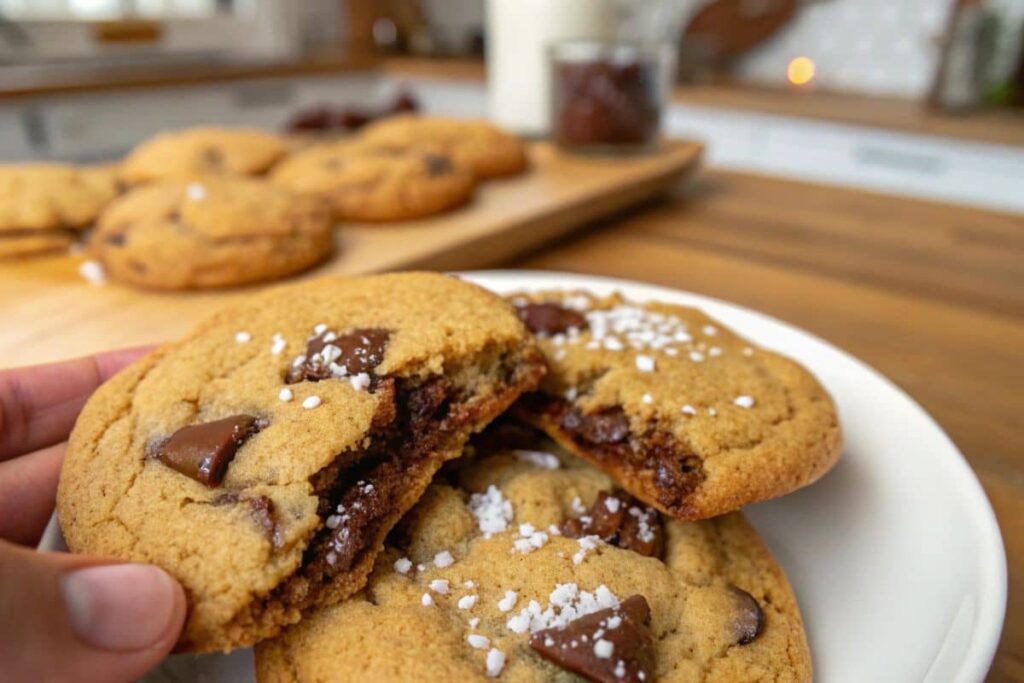
Classic Chocolate Chip Cookies with a Twist
The humble chocolate chip cookie is a classic for a reason. But why not add a twist to make it unforgettable? Here’s how you can elevate your chocolate chip cookies to gourmet status:
- Brown Butter Magic: Brown your butter before mixing it into the dough. This simple step adds a nutty, caramel-like depth of flavor that’s irresistible.
- Chopped Chocolate Over Chips: Instead of chocolate chips, use chopped chocolate bars. The uneven pieces create gooey pockets of melted chocolate that chips just can’t compete with.
- Sea Salt Finishing Touch: Sprinkle a pinch of flaky sea salt over your treats just before baking. The sweet-and-salty contrast will blow your mind!
Pro Tip: Chill the dough for 24 hours to let the flavors deepen and the texture improve. Trust me, it’s worth the wait! 🍪
Oatmeal Raisin Cookies with the Perfect Chew
Oatmeal raisin cookies have their fans, and with this recipe, you might just convert the skeptics. The secret lies in making the raisins plump and juicy while ensuring the oats don’t overpower the texture. Here’s how to get that perfect balance:
- Raisin Revival: Soak the raisins in warm water, orange juice, or even a splash of rum (for adults) for about 15 minutes. This prevents them from drying out during baking.
- Balance the Oats: Use a mix of quick oats and old-fashioned rolled oats. The quick oats blend seamlessly into the dough, while the rolled oats provide that classic chewy texture.
- Spice It Up: Add a pinch of cinnamon and nutmeg for a cozy, warm flavor. 🥰
Pro Tip: Add a tablespoon of molasses or honey for an extra layer of moisture and flavor.
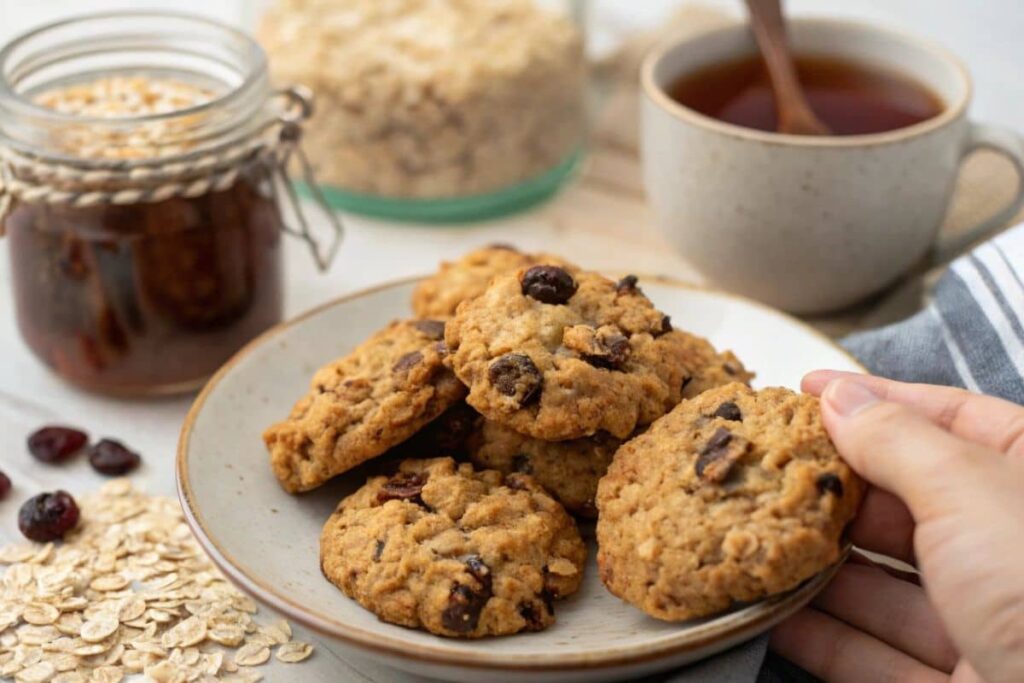
Double Chocolate Chunk Treats for Crispy Edges and Soft Centers
Calling all chocoholics! These indulgent bites are loaded with double the chocolate for double the joy. But what makes them truly special is their texture—crispy edges with soft, gooey centers. Here’s how to achieve perfection:
- Cocoa Powder Base: Use high-quality cocoa powder for a rich, chocolatey flavor. Dutch-processed cocoa works best for a darker, more intense taste.
- Chocolate Chunks Galore: Skip the chips and go for chunks or chopped chocolate bars. Aim for a mix of milk and dark chocolate for the ultimate flavor combo.
- Underdone Is Perfect: Pull the cookies out of the oven while the centers still look underbaked. They’ll continue to set as they cool, leaving you with a perfectly soft middle.
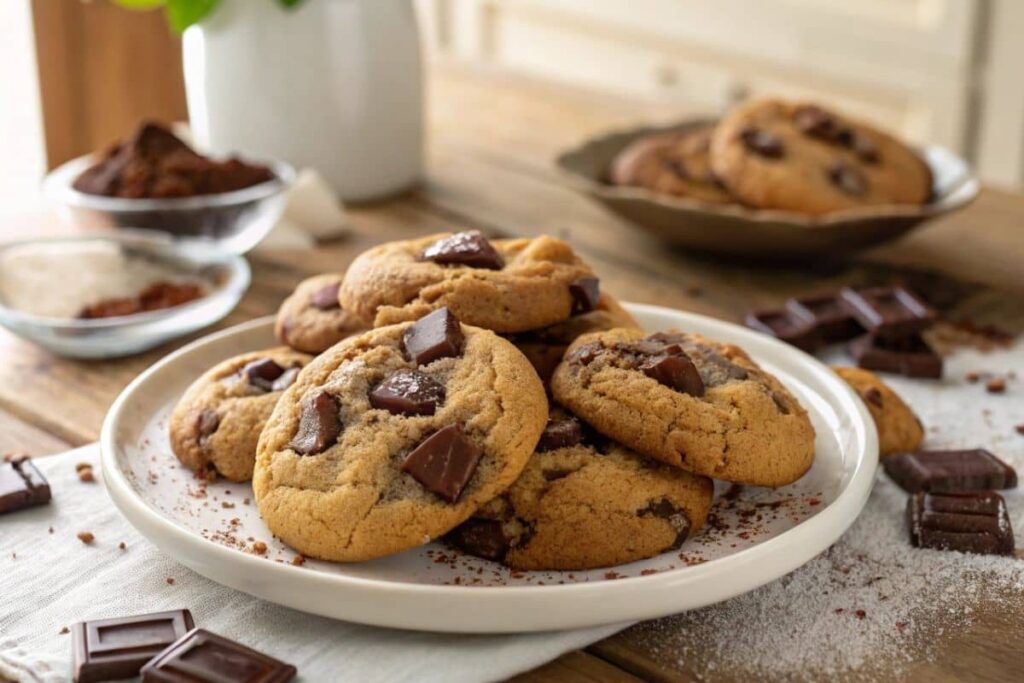
Peanut Butter Blossoms with a Surprise Center
These classic cookie get an upgrade with a hidden surprise in the center. Imagine biting into a soft peanut butter cookie and discovering a gooey chocolate center—it’s pure magic! ✨
- Choose the Right Peanut Butter: Creamy peanut butter works best for smooth, cohesive dough. Natural peanut butter might separate, so stir it thoroughly if you use it.
- Add a Chocolate Core: Wrap a small piece of milk chocolate or a chocolate truffle in the dough before rolling it into balls.
- Decorate for Fun: Roll the dough balls in sugar for a sparkly, crunchy coating.
Pro Tip: Press a classic chocolate kiss into the top of the cookie immediately after baking for a signature peanut butter blossom look.
Snickerdoodles with a Crisp Twist
If you think snickerdoodles are just cinnamon sugar cookies, think again! Here’s how to make them crispy yet chewy, with a flavor profile that will have everyone asking for the recipe:
- Use Cream of Tartar: This ingredient gives snickerdoodles their signature tangy flavor and chewy texture. Don’t skip it!
- Double the Cinnamon: Add a touch of cinnamon to the dough itself, not just the coating. The extra spice makes these cookies irresistible. 🌟
- Sugar Coating: Roll the dough balls generously in a cinnamon-sugar mix for a crunchy, flavorful exterior.
Pro Tip: Bake the cookies on a parchment-lined baking sheet to ensure even browning.
White Chocolate Macadamia Nut Cookies with a Tropical Flair
For something a little fancy, try white chocolate macadamia nut cookies. The combination of creamy white chocolate and crunchy macadamia nuts is heavenly, but adding a tropical twist takes them over the top:
- Toasted Nuts: Lightly toast the macadamia nuts before adding them to the dough. It enhances their natural sweetness and crunch.
- Coconut Love: Add a handful of shredded coconut to the dough for a subtle tropical flavor. 🥥
- Balance the Sweetness: Use a pinch of sea salt to balance the sweetness of the white chocolate.
Pro Tip: Let the cookies cool completely before serving to allow the white chocolate to set properly.
Expert Hacks for Consistently Amazing Cookies
Use Parchment Paper for Even Baking
One of the best ways to prevent your treats from spreading unevenly or sticking to the tray is to use parchment paper. Not only does it create a smooth surface for baking, but it also ensures they retain their shape without crumbling. If you’re wondering how to avoid the dreaded crumble, this simple hack is your answer.
Invest in an Oven Thermometer
Did you know that uneven heat can be a hidden culprit for cookie crumble issues? Your oven might not always be at the temperature you think it is. By using an oven thermometer, you can make sure your cookies bake evenly and hold their structure every time. It’s a small investment that saves you from crumbling disasters. 🔥🍪
Rotate Your Baking Sheets
Hot spots in your oven can lead to uneven baking—some treats turn out too soft, others too hard, and yes, more prone to crumbling. Halfway through baking, rotate your baking sheets from top to bottom and front to back. This keeps everything consistent and reduces the chances of unexpected crumbles.
Let Dough Rest for Enhanced Flavor
Patience pays off in baking. Letting your dough rest in the fridge not only enhances flavor but also prevents excessive spreading, which can lead to treats crumbling apart. For doughs prone to breaking, this step is a game-changer.
Chill Your Dough Before Baking
Chilling your dough isn’t just for flavor—it’s also a top trick for avoiding crumbling. By firming up the fat in the mixture, chilling helps baked treats develop a sturdier structure, ensuring they hold together perfectly.
Use a Cookie Scoop for Even Sizing
Evenly sized treats bake more consistently and are less likely to crumble. A scoop ensures uniformity, so you don’t end up with underbaked centers or overbaked edges that lead to breakage. Pro tip: Always level off your scoop for the best results!
These expert tips will take your baking to the next level, minimizing the chances of dreaded crumbles while ensuring consistently amazing results.
Conclusion: Master the Art of Cookie Baking
Baking the perfect treat isn’t just about following a recipe—it’s about understanding the process, troubleshooting when things go wrong, and experimenting with creative ideas. Whether you’re a beginner or a seasoned baker, these expert hacks will help you create baked goods that are not only delicious but also structurally sound. So grab your ingredients, preheat that oven, and let’s make something that doesn’t just crumble—it steals the show!
Frequently Asked Questions (FAQ) About Cookie Crumbling
What Makes a Cookie Crumble?
The texture and stability of cookies depend on a delicate balance of ingredients, mixing techniques, and baking time. Too much flour, overmixing, or baking at an incorrect temperature can lead to crumbly cookies. For detailed insights, check out our guide on cookie crumble to troubleshoot and perfect your baking techniques.
What Is the Secret to a Crunchy Cookie?
If you love a treat that’s delightfully crunchy, the secret lies in using the right ingredients and techniques. Granulated sugar and a slightly longer bake time are key players. Also, reducing the moisture content by using egg whites instead of whole eggs can make a difference. For more tips, visit our article: What is the secret to a crunchy bake?
How Do You Keep Crumble Cookies Good?
To keep your crumble treats fresh and delicious, proper storage is essential. Use airtight containers and store them at room temperature for a softer texture or in the fridge for a firmer bite. For long-term storage, freezing is an excellent option. Check out our detailed storage hacks in the guide: How do you keep baked goods fresh?
Can I Fix Overly Crumbly Dough?
Yes! If your cookie dough feels too crumbly, add a tablespoon of milk or cream at a time until it comes together. This small adjustment can save the day and help you achieve perfect cookies.
Why Do Cookies Spread Too Much During Baking?
Excessive spreading can occur when the butter is too soft or melted, or when there’s too little flour in the dough. Chilling the dough before baking and measuring your ingredients accurately can prevent this issue.
What’s the Best Way to Store Cookie Dough?
The best way to store cookie dough is to scoop it into portions, freeze them on a baking sheet, and then transfer them to a freezer-safe bag. This allows you to bake fresh cookies anytime you want without extra prep!
How Long Should I Chill My Cookie Dough?
For best results, chill your cookie dough for at least 30 minutes, but overnight chilling (up to 24 hours) is ideal for enhancing flavors and improving texture.

Perfectly Baked Cookies
Ingredients
Basic Ingredients
- 2 cups All-Purpose Flour
- 1 cup Butter Use melted butter for flatter cookies or cold butter for more structure.
- 1 cup Sugar Mix of granulated and brown sugar recommended for moisture.
- 2 large Eggs One additional yolk for chewier texture.
- 1 tsp Vanilla Extract
Additions for Variations
- 1 cup Chocolate Chunks Mix of dark and milk chocolate for an indulgent flavor.
- 1 cup Raisins Soak in warm water or orange juice for a plump texture.
- 0.5 cups Chopped Nuts (e.g., macadamia) Toast for added flavor.
Instructions
Preparation
- Preheat the oven to 350°F (175°C).
- In a mixing bowl, cream together the butter and sugars until light and fluffy.
- Add eggs one at a time, beating well after each addition, then stir in the vanilla.
- In another bowl, combine flour and any additional dry ingredients (like baking soda if needed).
- Gradually add the dry ingredients to the wet mixture, stirring until just combined.
- Fold in any additional mix-ins such as chocolate chunks or nuts.
Baking
- Drop spoonfuls of cookie dough onto a parchment-lined baking sheet, spacing them apart.
- Bake for 10-12 minutes until edges are golden, but centers are just set.
- Remove from oven and let cool on the baking sheet for 5 minutes before transferring to a wire rack.

